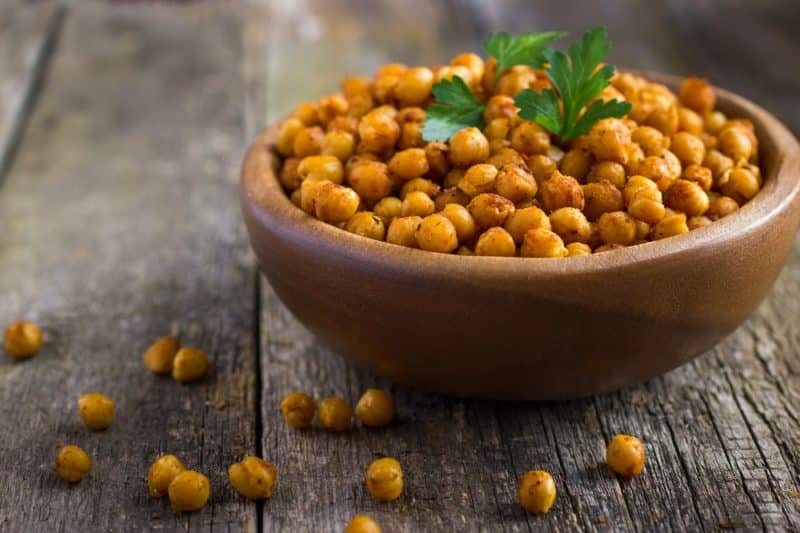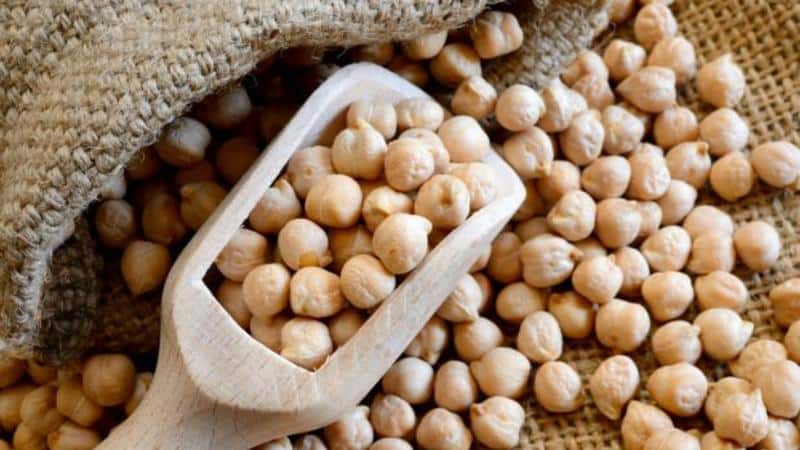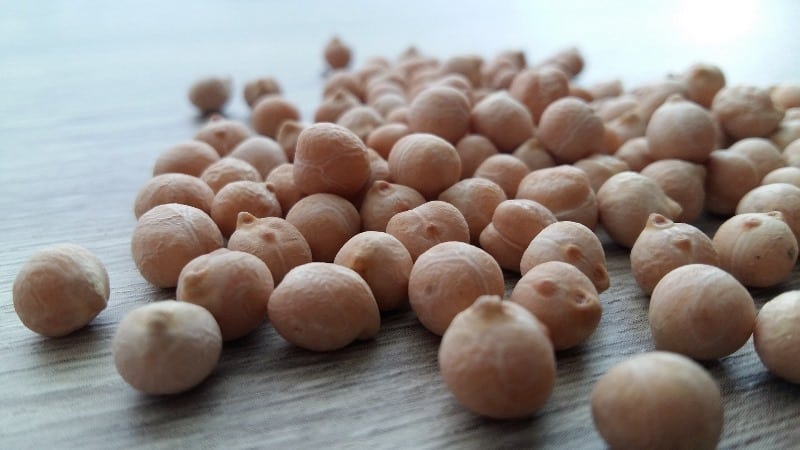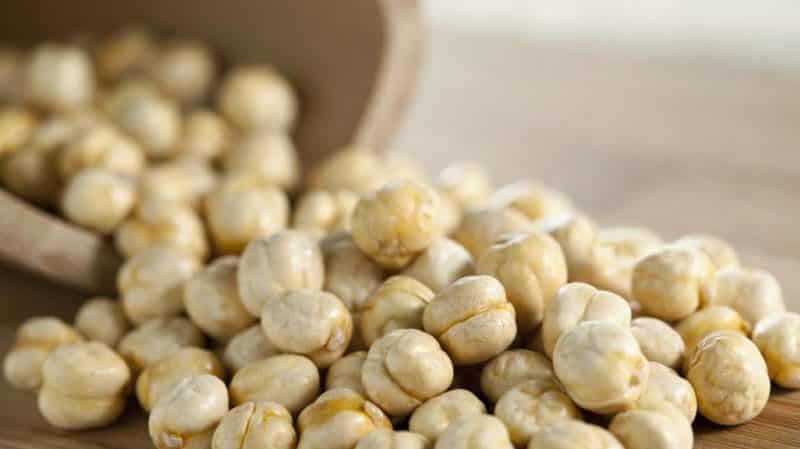Chickpeas - composition, calorie content, benefits and harm
Chickpeas appeared on the shelves of domestic stores not so long ago, but have already gained well-deserved popularity. Turkish peas contain so many useful elements that they alone can replace half of the diet. And thanks to the low glycemic index, this product is indicated for weight loss and in the diet of patients with diabetes.
Contents of chick peas
Adherents of a healthy lifestyle prefer to eat chickpeas raw or sprouted. This type of product is the healthiest, as it is maximally filled with energy, vitamins and minerals.

The nutritional value
The composition (BJU) and calorie content in raw and thermally processed products are different. Raw chickpeas provide the most energy. Boiled has the fewest calories: it is in this form that nutrition experts recommend consuming it.
| Nutritional value of chickpeas (per 100 g) | In the damp | Varen | Fried |
| Squirrels | 8.8 g | 8.3 g | 15 g |
| Fats | 1.8 g | 1.9 g | 37 g |
| Carbohydrates | 18.1 g | 19.3 g | 48 g |
| Cellulose | 3 g | 7.6 g | 7.6 g |
| Calorie content | 376 kcal | 127 kcal | 518 kcal |
According to the Ministry of Health of the Russian Federation, the most optimal ratio of BZHU according to healthy nutrition standards is found in fried chickpeas. However, its high calorie content does not make it possible to recommend this method of preparation for dietary nutrition.
Important! Chickpeas are part of a diet that reduces the risk of heart disease, one of the leading causes of death for men and women over 50 years of age.
Chemical composition
Chickpeas are rich in vitamins, minerals, saturated and unsaturated fatty acids. This makes it a valuable product that supplies most of the elements necessary for the human body.

Vitamin content (per 100 g):
- A (retinol) – 15 mcg;
- B1 (thiamine) – 0.1 mg;
- B6 (pyridoxine) – 0.5 mg;
- B9 (folic acid) – 650 mcg;
- C (ascorbic acid) – 4 mg;
- K – 33 mg;
- RR – 3.3 mg.
Microelements (per 100 g):
- iron – 2.5 mg;
- copper – 352 mcg;
- manganese – 2 mg;
- zinc – 2.8 mg;
- selenium – 28.1 mg.
Macroelements (per 100 g):
- potassium – 966 mg;
- sulfur – 191 mg;
- calcium – 190 mg;
- magnesium – 123 mg;
- phosphorus – 1215 mg;
- sodium – 70 mg.
The composition of vitamins and minerals is indicated for the raw product.
Reference. During heat treatment, some elements are destroyed. For example, the content of vitamins A and C in raw chickpeas is four times higher than in boiled or fried chickpeas.
Health benefits and harms of chickpeas

Turkish peas are a valuable source of easily digestible protein. In terms of properties, doctors equate it to chicken. For this reason, chickpeas are an indispensable product for raw foodists, vegans, and people with poor health.
Read also:
We preserve the taste and beneficial properties all year round: pea pods.
Beneficial features
Lamb peas have a beneficial effect on almost all organs and systems of the body. Due to the presence of rare minerals in its composition, it is used for a wide variety of diseases and conditions.
The health benefits of chickpeas are determined by its composition:
- polyunsaturated fatty acids omega-3 and omega-6, essential amino acids strengthen the cardiovascular system;
- fiber has a beneficial effect on the functioning of the digestive tract, gently emptying the intestines and preventing constipation, which is important in adulthood and with a tendency to be overweight;
- carbohydrates and proteins contribute to long-term satiety, which prevents the desire to snack between meals;
- calcium and phosphorus are building materials for bones;
- High iron content increases the level of hemoglobin in the blood, as a result of which all organs are better supplied with oxygen.
In addition, chickpeas are indicated for cataracts to improve the circulation of intraocular fluid, for diabetes - to reduce insulin resistance, and for atherosclerosis - to reduce the level of “bad” cholesterol.
For women

For women, chickpeas replace a cosmetic bag. It stimulates collagen production, which improves skin tone and keeps it youthful longer.
Folic acid in the product is indicated for women during pregnancy, and iron is indicated for maintaining high hemoglobin, which reduces the risk of fetal hypoxia.
Protein and calcium support healthy hair, nails, and teeth.
Chickpeas are indispensable for weight loss, since they not only reduce appetite and replenish the body’s nutritional needs, but also eliminate cravings for flour and sweets.
Important! During breastfeeding, chickpeas in a woman’s diet enhance lactation.
For men
Eating chickpeas helps:
- building muscle mass thanks to amino acids;
- increased testosterone production due to the presence of selenium;
- increases sperm motility.
Men who regularly consume chickpeas maintain potency and quality of sexual relationships much longer than those who neglect this product.
For children
Like all legumes, chickpeas begin to be introduced into the diet of children from the age of one and a half years. Since a plant product can cause an allergic reaction, complementary feeding begins with small portions - 1-2 tsp, gradually increasing the volume of Turkish peas in the menu.
Chickpeas provide the growing body with building material for organs and systems, as well as many of the elements it needs.
Important! The first time you take chickpeas should be on its own – in the form of puree. This way, parents can immediately see if there is an undesirable reaction.
Thanks to their light nutty flavor, chickpeas will please even the pickiest kids. It is used to prepare soups, cutlets, cereals, purees and even candies.
Contraindications and possible harm

Despite all its benefits, chickpeas also have contraindications. First of all, individual intolerance to plant protein.
Moderate consumption of chickpeas is possible during the period of remission in the presence of diseases:
- gout;
- thrombophlebitis;
- stomach ulcer;
- cystitis.
With caution - if you are prone to flatulence. During breastfeeding, mother's chickpeas are allowed no earlier than the baby's intestinal function has improved, that is, 4-6 months after birth.
Read also:
What is the difference between chickpeas and peas: shape, taste, composition
Comparing chickpeas and peas: calorie content, application, benefits
Conclusion
Regular consumption of chickpeas replenishes the deficiency of many vitamins and minerals. When consumed in moderation, it does not lead to weight gain; on the contrary, it promotes weight loss by stimulating metabolism.
Chickpeas are shown to prevent cardiovascular diseases. Helps with intestinal disorders, strengthens bones, improves skin condition, prolongs the youth of men and women.If there is stagnation of blood in the lower extremities, inflammation of the bladder, peptic ulcers and gout, we recommend consulting with your doctor before introducing the product into your diet.